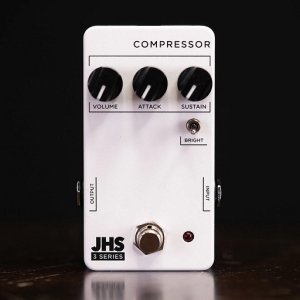Spirit of 76
New member
Wife got me the JHS Series 3 Compressor for Christmas and I really like it.
I wanted a compressor because I felt that with my gear, notes (especially higher notes) were decaying just a little sooner than I wanted so I was looking to increase sustain.
This pedal does that perfectly, so mission accomplished for what I wanted.
But it is really well built (sturdy metal housing; not some cheap plastic junk), it's slightly smaller than a normal sized pedal but it's certainly not a mini. And it's made in the USA so you can't beat that.
Plus these Series 3 pedals are all $99, so it's decently priced for a well made, brand new pedal.
It also has a brightness switch that pushes up the mids and highs (with distortion or fuzz, it kinda gives you a Boston-ish sound). The brightness switch also sounds good on a clean tone if you are looking for that higher pitched sound.
My only complaint is that it doesn't sound good on a clean tone; since it's 'compressing' the sound it really flattens out the clean tone quite a bit if you are not using the brightness switch, but hey, that's what its suppose to do.
Anyway I give it a 5 of 5 because it (a) did exactly what I wanted, (b) it's well made, and (c) affordably priced.
I wanted a compressor because I felt that with my gear, notes (especially higher notes) were decaying just a little sooner than I wanted so I was looking to increase sustain.
This pedal does that perfectly, so mission accomplished for what I wanted.
But it is really well built (sturdy metal housing; not some cheap plastic junk), it's slightly smaller than a normal sized pedal but it's certainly not a mini. And it's made in the USA so you can't beat that.
Plus these Series 3 pedals are all $99, so it's decently priced for a well made, brand new pedal.
It also has a brightness switch that pushes up the mids and highs (with distortion or fuzz, it kinda gives you a Boston-ish sound). The brightness switch also sounds good on a clean tone if you are looking for that higher pitched sound.
My only complaint is that it doesn't sound good on a clean tone; since it's 'compressing' the sound it really flattens out the clean tone quite a bit if you are not using the brightness switch, but hey, that's what its suppose to do.
Anyway I give it a 5 of 5 because it (a) did exactly what I wanted, (b) it's well made, and (c) affordably priced.
Attachments
Last edited:

